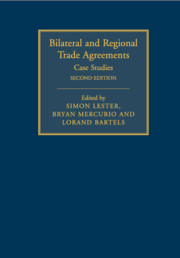Book contents
- Frontmatter
- Contents
- Contributors
- Table of cases
- Table of treaties and international agreements
- List of abbreviations
- 1 The United States–Korea Free Trade Agreement
- 2 EU–Korea Free Trade Agreement
- 3 United States–Colombia Trade Promotion Agreement
- 4 China–New Zealand Free Trade Agreement
- 5 China–Taiwan Free Trade Agreement
- 6 The ASEAN–Australia–New Zealand FTA (AANZFTA)
- 7 The CARIFORUM–EU Economic Partnership Agreement
- Index
6 - The ASEAN–Australia–New Zealand FTA (AANZFTA)
Published online by Cambridge University Press: 05 December 2015
- Frontmatter
- Contents
- Contributors
- Table of cases
- Table of treaties and international agreements
- List of abbreviations
- 1 The United States–Korea Free Trade Agreement
- 2 EU–Korea Free Trade Agreement
- 3 United States–Colombia Trade Promotion Agreement
- 4 China–New Zealand Free Trade Agreement
- 5 China–Taiwan Free Trade Agreement
- 6 The ASEAN–Australia–New Zealand FTA (AANZFTA)
- 7 The CARIFORUM–EU Economic Partnership Agreement
- Index
Summary
Introduction
The ASEAN–Australia–New Zealand FTA (AANZFTA) combines two different pre-existing country groupings of long-standing. The first of these is ASEAN, the Association of Southeast Asian Nations, which was founded in 1967 by Indonesia, Malaysia, the Philippines, Singapore and Thailand. This grouping has expanded over the years, with Brunei Darussalam joining in 1984, followed by Vietnam in 1995, Laos and Myanmar in 1997, and Cambodia in 1999. While ASEAN has existed for nearly 50 years, for most of that period it has served as an alliance based on economic and political cooperation rather than as a free trade agreement. However, the original members of ASEAN launched a free trade initiative, the ASEAN Free Trade Area (AFTA), in 1992. In 2003, after the expansion of ASEAN to its current membership, ASEAN announced plans to create an ASEAN Community comprising three pillars, one of which would be a free trade agreement to be called the ASEAN Economic Community. In 2007, this intention was memorialized in writing with a timetable to form the Community by 2015.
The other pre-existing alliance was that between Australia and New Zealand, which have a long history of formal trade agreements. In 1965, close in time to the creation of ASEAN, these Oceania neighbours formed a free trade agreement known as the New Zealand–Australia Free Trade Agreement. This FTA was eclipsed in 1983 by the highly ambitious Australia–New Zealand Closer Economic Relations Trade Agreement (ANZCERTA), most commonly referred to as Closer Economic Relations (CER).
Given the linkages already in place between the ASEAN countries on the one hand, and Australia and New Zealand on the other, the primary trade gains to be had pursuant to AANZFTA lie in new linkages between Australia and New Zealand and specific ASEAN members. Indeed, pursuant to an exchange of letters bearing treaty status, Australia and New Zealand have agreed that AANZFTA obligations only apply between them to a limited extent, including the tariff and Rules of Origin (ROO) commitments and the General Exceptions chapter.
Following several years of negotiations, these two groupings formed the ASEAN–Australia–New Zealand Free Trade Agreement (AANZFTA), which came into force on 1 January 2010 for most of its participants. AANZFTA has been in effect for all participants since January 2012.
- Type
- Chapter
- Information
- Bilateral and Regional Trade AgreementsCase Studies, pp. 114 - 132Publisher: Cambridge University PressPrint publication year: 2016
- 1
- Cited by



